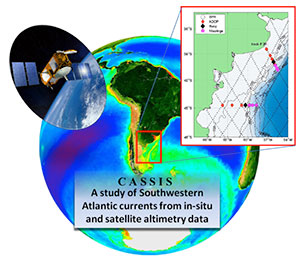Towards High Resolution Altimetry: evaluation of products in the Southwestern Atlantic
Author:
Martin Saraceno - (UMI-IFAECI)
Co-Investigator(s):
Christine Provost (LOCEAN)
Alberto R. Piola (UMI-IFAECI)
Nathalie Sennéchael (LOCEAN)
Alejandro Bianchi (UMI-IFAECI)
Ramiro Ferrari (UMI-IFAECI)
Elbio D. Palma (UNS-CONICET)
Raul Guerrero (INIDEP)
Abstract:
This proposal has two main objectives: (i) to evaluate new experimental CLS-CNES and traditional altimetry products in a very dynamic region, (ii) to improve our understanding of the dynamics of the Malvinas Current and its role in mixing or separating open ocean and continental shelf waters through the use of altimetry, in-situ and model output data.
Our proposal consists in a follow-up study of the Malvinas CNES-funded project (2012-2016, Southwestern Atlantic currents from in-situ and satellite altimetry, www.cima.fcen.uba.ar/malvinascurrent). Thanks to that project we were able to deploy sixteen moorings along two transects that covered the Patagonian shelf and shelf-break. Data obtained from the first transect provided, for the first time, year-long time series of currents over the Patagonian continental shelf which allowed the evaluation of altimetry data. The full exploitation of the dataset, including data from the second transect, will permit to address specific questions:
- To which extent can we use satellite altimetry in the Patagonian Shelf to study the ocean circulation?
- How has the Malvinas Current transport at 41°S changed over 24 years? Why?
- Is there a relationship between the Malvinas current transport variability and the currents in the Patagonian shelf?
- What is the Malvinas Current transport at 45°S? How does it vary? Why? What are the impacts of those variations? What are the relations between the transport at 45ºS and 41ºS?
The in-situ data from CASSIS-Malvinas offer an exceptional opportunity to evaluate at the same time new and traditional altimetry products, which is the first main objective of this proposal. The second main objective is motivated by recent studies that suggest that the MC can act as a barrier or as a blender between open ocean and shelf waters. The two roles have deep consequences on the primary productivity on both the continental shelf and shelf-break. The combination of altimetry, in-situ and model output data is proposed to investigate this problem.

